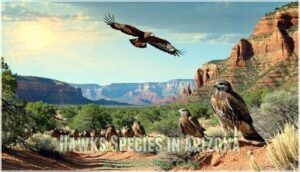This site is supported by our readers. We may earn a commission, at no cost to you, if you purchase through links.

The state hosts 23 magnificent raptors, including the massive Great Horned Owl that owns the night shift and Red-tailed Hawks circling overhead during your morning hike.
Arizona’s diverse landscapes create perfect hunting grounds for everything from tiny American Kestrels to powerful Golden Eagles.
The Sonoran Desert alone supports species like Harris’s Hawks, which hunt in coordinated packs like wolves with wings.
Whether you’re scanning saguaro forests or rocky canyons, these apex predators have mastered every habitat.
Each species brings unique hunting strategies that’ll change how you view Arizona’s wild spaces.
Table Of Contents
- Key Takeaways
- Largest Bird of Prey in Arizona
- Most Common Hawk in Arizona
- Bird of Prey in The Sonoran Desert
- Falcons Found in Arizona
- Types of Eagles in Arizona
- Hawks Species in Arizona
- Falcons Native to Arizona
- Ospreys in Arizona
- Harriers in Arizona
- Where to Find Hawks in Arizona
- Frequently Asked Questions (FAQs)
- What is Arizona’s State Bird of Prey?
- Which hawk in Arizona is the largest?
- What is largest bird of prey in Arizona?
- What is the most common hawk in Arizona?
- What is the bird of prey in the Sonoran Desert?
- What kind of falcons are in Arizona?
- What time of day are raptors most active?
- How do Arizona raptors adapt to extreme heat?
- Can urban development benefit certain raptor species?
- What role do raptors play in controlling pests?
- Conclusion
Key Takeaways
- You’ll find 23 different raptor species ruling Arizona’s skies, from the massive Golden Eagles with 7.5-foot wingspans to tiny American Kestrels that hover over grasslands hunting insects.
- Red-tailed Hawks dominate at 65% of Arizona’s raptor population, and you’ll spot them everywhere from Phoenix suburbs to remote desert canyons thanks to their incredible adaptability.
- Arizona’s diverse landscapes create unique hunting opportunities – Harris’s Hawks hunt in coordinated packs like wolves in the Sonoran Desert, while Peregrine Falcons dive at 240+ mph from urban towers and cliff faces.
- You can observe these magnificent predators year-round at premier locations like Tubac HawkWatch (2,000+ raptors annually), Santa Cruz Flats for wintering Ferruginous Hawks, and Verde Valley’s river corridors that support multiple species.
Largest Bird of Prey in Arizona
Arizona’s raptor-royalty commands attention when you’re exploring the desert southwest.
The golden eagle and bald eagle dominate Arizona’s skies as the state’s largest birds of prey, with impressive wingspan comparisons reaching up to 7.5 feet across.
These arizona eagles showcase remarkable weight differences – golden eagles tip the scales at 14 pounds while maintaining their status as apex predators.
You’ll discover fascinating hunting strategies between these giants.
Golden eagles prefer open terrain, swooping down on rabbits and prairie dogs, while bald eagles focus on fish and waterfowl near Arizona’s lakes and rivers.
Their habitat preferences differ too – golden eagles favor mountainous regions and desert landscapes, whereas bald eagles stick closer to water sources.
Both species have remarkable conservation status stories.
Bald eagles bounced back from near-extinction, and golden eagles maintain stable populations.
When you’re spotting arizona raptors, these magnificent arizona birds of prey represent nature’s perfect engineering – powerful, graceful, and absolutely unforgettable.
Cormorants, while not raptors, also inhabit Arizona and their populations are impacted by available artificial structures.
Most Common Hawk in Arizona
When you’re scanning Arizona’s skies, you’re most likely spotting a Red-tailed Hawk – these birds of prey dominate the state’s raptor population at an impressive 65%. These Arizona raptors have mastered hawk adaptations that let them thrive everywhere from Phoenix suburbs to remote desert canyons.
Red-tailed habitat preferences make them incredibly versatile. You’ll find them perched on saguaro cacti, utility poles, and skyscraper ledges with equal comfort. Their urban hawk diet includes rodents, rabbits, and even the occasional snake, making them nature’s pest control specialists.
For hawk identification, look for their signature rusty-red tail and broad wings spanning up to 52 inches. These hawks demonstrate remarkable resilience in Arizona’s challenging environment. They breed in tall trees or urban buildings.
Hawk conservation efforts benefit from their adaptability, though they still face threats from vehicle strikes and habitat loss. Supporting these magnificent Arizona birds means preserving open spaces where Redtailed Hawks can continue their essential role in maintaining ecological balance across the state.
Bird of Prey in The Sonoran Desert
Survival in America’s hottest desert demands extraordinary adaptations from Arizona birds of prey.
The Sonoran Desert’s harsh landscape shapes every aspect of raptor life, from hunting strategies to nesting choices.
You’ll find Red-tailed Hawks and Harris’s Hawks making homes in towering saguaro cacti, their massive arms providing perfect nesting platforms high above the desert floor.
Water scarcity forces these predators to extract moisture from their prey, while extreme temperatures dictate dawn and dusk hunting schedules.
Bald eagles maintain territories throughout Arizona’s desert regions, surprisingly thriving in this arid environment.
Golden eagles dominate the Lower Colorado River Valley, their keen eyes scanning for jackrabbits and ground squirrels.
Unfortunately, habitat loss threatens species like the declining Burrowing Owl.
Conservation efforts now focus on protecting key desert wash corridors where these magnificent hunters breed and raise their young, ensuring Arizona wildlife continues flourishing.
The California Condor’s wingspan is impressive, rivaling that of eagles found in Arizona, with a notable wingspan.
Falcons Found in Arizona
Soaring through Arizona’s vast desert landscapes, falcons represent some of the most skilled aerial hunters among birds of prey. These remarkable raptors have mastered falcon identification through their distinctive hunting styles and physical characteristics.
Arizona hosts several falcon species, each perfectly adapted to the state’s diverse falcon habitats.
When exploring Arizona birds of prey, you’ll discover these fascinating falcon characteristics:
- Peregrine falcon – The world’s fastest bird, diving at speeds exceeding 200 mph to catch prey
- Prairie falcon – Masters of low-altitude hunting across desert grasslands and sagebrush flats
- American Kestrel – North America’s smallest falcon, specializing in insects and small rodents
- Falcon migration patterns bring seasonal visitors during spring and fall months
Understanding falcon diet reveals their ecological importance – they primarily hunt birds, small mammals, and insects. Falcon conservation efforts have successfully restored populations, particularly benefiting peregrine falcons.
Some raptors, like the Golden Eagle’s large wingspan, allow them to hunt at high altitudes. Whether you’re interested in falconry arizona or simply appreciating these magnificent hunters, Arizona’s falcons offer unforgettable wildlife viewing opportunities.
Types of Eagles in Arizona
You’ll encounter two magnificent eagle species calling Arizona home year-round. Bald eagles and golden eagles represent the pinnacle of arizona wildlife, showcasing nature’s most impressive raptors.
Bald eagle populations have staged a remarkable comeback from near-extinction. These iconic birds of prey now thrive around Arizona’s lakes and rivers, where eagle sightings are increasingly common. You’ll recognize them by their distinctive white heads and tails once they reach maturity.
Arizona’s majestic bald eagles have soared back from the brink, now commanding lakeshores with their iconic white crowns.
Golden eagles prefer Arizona’s rugged desert landscapes and mountain terrain. They’re incredibly adaptable, thriving in diverse eagle habitats from grasslands to woodland-brushlands. These powerful hunters lack the white markings of their bald cousins. The Accipitridae family classifies these eagles among others.
Eagle conservation efforts continue protecting both species’ nesting sites. Eagle identification becomes easier with practice—watch for size differences and habitat preferences. Both species contribute to Arizona’s incredible diversity of 551 bird species, making the state a premier destination for raptor enthusiasts.
Hawks Species in Arizona
Arizona raptor-watchers know that hawks are the power gliders and sharp-eyed hunters of the region’s wild tapestry.
Arizona’s bird diversity shines in its hawk species, each offering unique clues for hawk identification.
The broad-winged Red-tailed Hawk dazzles with its rusty tail, while the dark-and-chestnut Harris’s Hawk, famous for pack-like hunting techniques, thrives in sparse woodlands and semi-desert.
Cooper’s Hawks—sleek, with rounded wings and long tails—dart like shadows through both urban and forest habitats.
Don’t overlook the Sharp-shinned Hawk, Arizona’s smallest, zipping through trees with acrobatic flair.
Great Blue Herons are also commonly spotted in the state.
Each plays a vital role in local ecosystems, helping keep rodent and songbird populations under control and supporting the larger conservation status of birds of prey.
If you’re out exploring Arizona wildlife, here’s what you might spot:
- Red-tailed Hawks circling over city parks
- Harris’s Hawks hunting in groups
- Cooper’s Hawks near suburban feeders
- Sharp-shinned Hawks darting along woodland edges
Falcons Native to Arizona
Moving from the broad-winged hawks to Arizona’s speed demons, you’ll find falcons that redefine aerial mastery.
These sleek hunters showcase unmatched falcon behavior through their lightning-fast hunting techniques and remarkable adaptability across diverse falcon habitats.
| Species | Top Speed | Hunting Style |
|---|---|---|
| Peregrine Falcon | 240+ mph | Spectacular diving attacks |
| Prairie Falcon | 90 mph | Low-altitude ground pursuit |
| American Kestrel | 39 mph | Precision hovering technique |
| Merlin | 30 mph | Agile bird-chasing flights |
Falcon identification becomes easier when you understand their unique characteristics.
The peregrine falcon dominates cliffs and urban towers, while the prairie falcon patrols open desert landscapes.
Your backyard might host an American kestrel hovering over grasslands, searching for insects and small rodents in its varied falcon diet.
The Atlanta Falcons, though not native to Arizona, adopted their name to reflect their strength and agility.
Falcon conservation efforts have successfully restored populations, particularly peregrine falcons, making Arizona a premier destination for observing these magnificent Arizona birds of prey in their natural environments.
Ospreys in Arizona
While falcons rule the speed game, ospreys bring their own brand of aerial mastery to Arizona’s waterways. These fish-eating specialists have made a remarkable comeback in the desert state, turning reservoirs and rivers into their personal hunting grounds.
Osprey Diet consists almost entirely of fish, making them nature’s most dedicated anglers. Their Migration Patterns bring them through Arizona during spring and fall, with some individuals staying year-round near permanent water sources.
Common Nighthawks are also present in the state, and can be identified by their distinct "peent" call.
Here’s what makes Arizona’s osprey population special:
- Habitat Preference centers on large water bodies like Patagonia Lake and the Salt-Verde River confluence
- Nesting Habits include building massive stick nests on utility poles and artificial platforms
- Their Conservation Status shows steady population growth after DDT-era recovery
- Hunting success rates reach 70% through specialized plunge-diving techniques
For Arizona birdwatching enthusiasts, these birds of prey offer spectacular fishing displays that’ll leave you speechless. Bird of prey identification becomes easy once you spot their distinctive white heads and fish-carrying flight patterns.
Harriers in Arizona
Gliding effortlessly over Arizona’s grasslands and marshes, Northern Harriers showcase one of nature’s most distinctive hunting styles. You’ll recognize these medium-sized raptors by their owl-like facial disks, white rump patches, and characteristic V-shaped wing posture during flight.
Harrier Identification becomes easier when you spot their low, weaving flight pattern. Males display gray plumage with white undersides, while females and juveniles sport brown streaking. These birds of prey measure 16-20 inches with impressive 38-48 inch wingspans.
Harrier Habitat preferences include Arizona’s wetlands and open grasslands, particularly around Alamo Lake State Park. Their Harrier Diet consists of small mammals, birds, and reptiles, which they locate using exceptional hearing abilities. Some Arizona wetlands also host year-round heron residents.
During Harrier Migration seasons, you’ll find these Arizona birds frequenting marsh edges and grassland corridors. Harrier Conservation efforts focus on protecting these essential Arizona ecosystems that support these remarkable raptors throughout their annual cycle.
Where to Find Hawks in Arizona
Looking for hawks across Arizona’s diverse ecosystems means knowing where these magnificent predators call home.
Whether you’re exploring urban hawk habitats or venturing into grassland hawk viewing areas, Arizona birdwatching spots offer incredible opportunities to observe these raptors in action.
Here’s where you’ll find the best hawk sightings:
- Tubac HawkWatch – Premier seasonal hawk migration viewing site with 2,000+ raptors annually
- Santa Cruz Flats – Ideal grassland hawk viewing for wintering Ferruginous Hawks
- Verde Valley – Excellent river hawk hotspots supporting multiple species year-round
Hawks use the perch-and-pounce hunting strategy to capture prey.
Frequently Asked Questions (FAQs)
What is Arizona’s State Bird of Prey?
You won’t find an official state bird of prey in Arizona’s records.
The state hasn’t designated one, unlike its official bird, the Cactus Wren.
However, you’ll spot magnificent raptors like Golden Eagles and Red-tailed Hawks throughout the desert landscape.
Which hawk in Arizona is the largest?
Soaring above Arizona’s rugged terrain like a feathered giant, you’ll spot the Ferruginous Hawk as the state’s largest hawk species.
With its impressive wingspan reaching up to 56 inches, it’s truly a magnificent sight.
What is largest bird of prey in Arizona?
You’ll spot the Golden Eagle as Arizona’s largest bird of prey, with its impressive wingspan reaching up to 7 feet 8 inches. These magnificent hunters dominate the skies, easily dwarfing other raptors.
What is the most common hawk in Arizona?
You’ll encounter Red-tailed Hawks most frequently across Arizona.
These adaptable raptors thrive everywhere from desert grasslands to busy urban areas, sporting their signature rusty-red tail feathers and impressive four-foot wingspan year-round.
What is the bird of prey in the Sonoran Desert?
You’ll encounter Red-tailed Hawks most frequently in the Sonoran Desert, soaring over open terrain with their distinctive rusty-red tails.
Harris’s Hawks also thrive here, hunting cooperatively in groups throughout Arizona’s desert landscapes.
What kind of falcons are in Arizona?
You’ll encounter three falcon species in Arizona: the lightning-fast Peregrine Falcon diving at 200+ mph.
The other two species include the ground-hunting Prairie Falcon with brown coloring, and the tiny American Kestrel with its distinctive rufous orange head and tail, showcasing a notable diversity.
What time of day are raptors most active?
Most raptors hunt during daylight hours when their keen eyesight works best.
You’ll see hawks and eagles soaring mid-morning through late afternoon.
Owls break this pattern, becoming active at dusk and throughout the night.
How do Arizona raptors adapt to extreme heat?
Heat-hammered hunters have honed helpful habits to handle Arizona’s harsh temperatures.
You’ll find they seek shade during scorching midday hours, pant like dogs to cool down, and hunt during dawn’s cooler embrace when prey’s more active, which involves harsh temperatures.
Can urban development benefit certain raptor species?
Urban environments surprisingly favor adaptable raptors like Cooper’s Hawks and Red-tailed Hawks.
You’ll find they thrive on abundant prey, nesting sites in buildings, and reduced competition.
Cities create perfect hunting grounds for these resourceful predators.
What role do raptors play in controlling pests?
You’ll find raptors are nature’s pest control specialists, hunting rodents, insects, and small mammals that damage crops and spread disease.
They’re incredibly efficient predators, keeping populations balanced naturally without harmful chemicals, which makes them incredibly valuable.
Conclusion
Spotting Arizona birds of prey beats scrolling through medieval bestiary manuscripts any day.
You’ve now got the field guide knowledge to identify 23 magnificent raptors across the state’s diverse landscapes.
From desert floors where Harris’s Hawks coordinate their pack hunts to mountain peaks where Golden Eagles soar, these apex predators showcase nature’s incredible adaptability.
Grab your binoculars and head outdoors – Arizona’s skies are waiting to reveal their feathered masters in action.
- https://www.rpi-project.org/publications/TP-07.pdf
- https://bioone.org/journals/journal-of-raptor-research/volume-47/issue-4/JRR-12-16.2/Nesting-Habitat-and-Productivity-of-Swainsons-Hawks-in-Southeastern-Arizona/10.3356/JRR-12-16.2.full
- https://digitalcommons.usf.edu/cgi/viewcontent.cgi?article=2650&context=jrr
- https://aura.antioch.edu/context/etds/article/1511/viewcontent/Losee_Dissertation2019.Final_copy.pdf
- https://academic.oup.com/jue/article/6/1/juaa023/5979497











